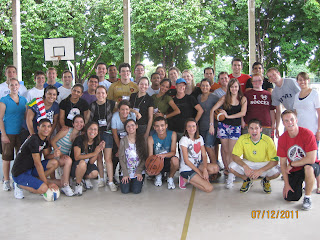Family home evening.
A hard-working Brazilian on a hot, crowded bus after a hard day of work getting some shut eye.
Festas Juninas are a huge part of the culture.
A man selling fresh fruits at the market, a job he has probably done for decades.
Music is very important to the Brazilian people.
A Brazilian man sitting on a street corner early in the morning, a common site on the Brazilian streets.
Xica, a hard-working and giving Brazilian woman.
A street vendor selling his delicious drink.
Hard-working and friendly Brazilian teenagers striving to learn English.
One of my brothers from the mission, Elder Eduardo.
Brazilian moving company moving a couch down from a skyscraping apartment building on ropes.
A hard-working Brazilian woman selling her delicious treat.
Devout Catholics, hundreds of them, at mass.
Conversing with a homeless man in a city square. Unfortunately, there are many of these throughout Brazil.
Some really friendly kids, this is one of my favorite pictures from my trip.
A yard worker taking a little break.
Brazilians love music, dancing, and partying (so I fit in well).
Going to the movies with our friend Polibio that we met on the beach.
One of the many people selling whatever they can on the beach. I bought some nice earrings for Camilia from this woman.
A fire-thrower doing his act in front of the cars stopped at a red light.
A full family living on the sidewalk with a busy street on one side and an open sewer on the other with all of their belongings.
Brazilians love to have paintings of their deceased parents and grandparents in their homes.
A stake dance with youth of the church.
A woman offering pictures for a few dollars.
Martial arts of Brazil.
A woman selling her treat on the street.
Nick and I amongst the Brazilians who invited us to the front of their mass.
Our knowledgeable tour guide Terry.
A samba band.
I thought this picture was interesting. We asked to take a picture with this woman, but she gave absolutely no facial expression. This is common among Brazilians who don't have white skin, they are embarrassed to take pictures because they normally don't have very high self-esteem.
One of my best friends, Elder Francisco.
Joao, with his stuffed frog Caco.
Cooking and cleaning of the house is very important to Brazilian woman.
Some of the people that matter the most to me in the world.
Eu amo o Brasil, e especialmente o povo Brasileiro, com tudo que eu sou.









































































